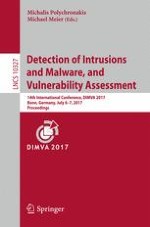2017 | OriginalPaper | Buchkapitel
BinShape: Scalable and Robust Binary Library Function Identification Using Function Shape
verfasst von : Paria Shirani, Lingyu Wang, Mourad Debbabi
Erschienen in: Detection of Intrusions and Malware, and Vulnerability Assessment
Aktivieren Sie unsere intelligente Suche, um passende Fachinhalte oder Patente zu finden.
Wählen Sie Textabschnitte aus um mit Künstlicher Intelligenz passenden Patente zu finden. powered by
Markieren Sie Textabschnitte, um KI-gestützt weitere passende Inhalte zu finden. powered by
